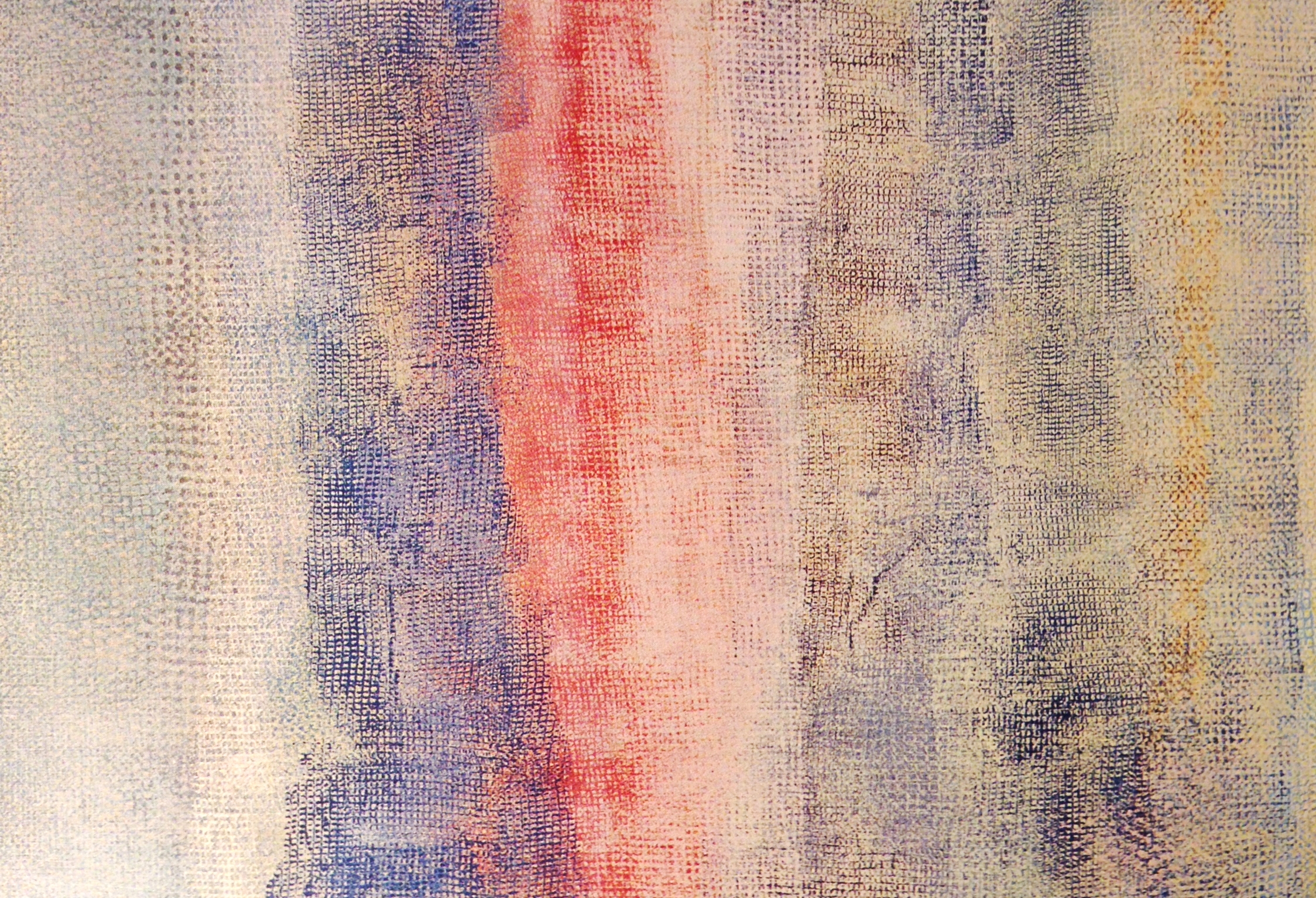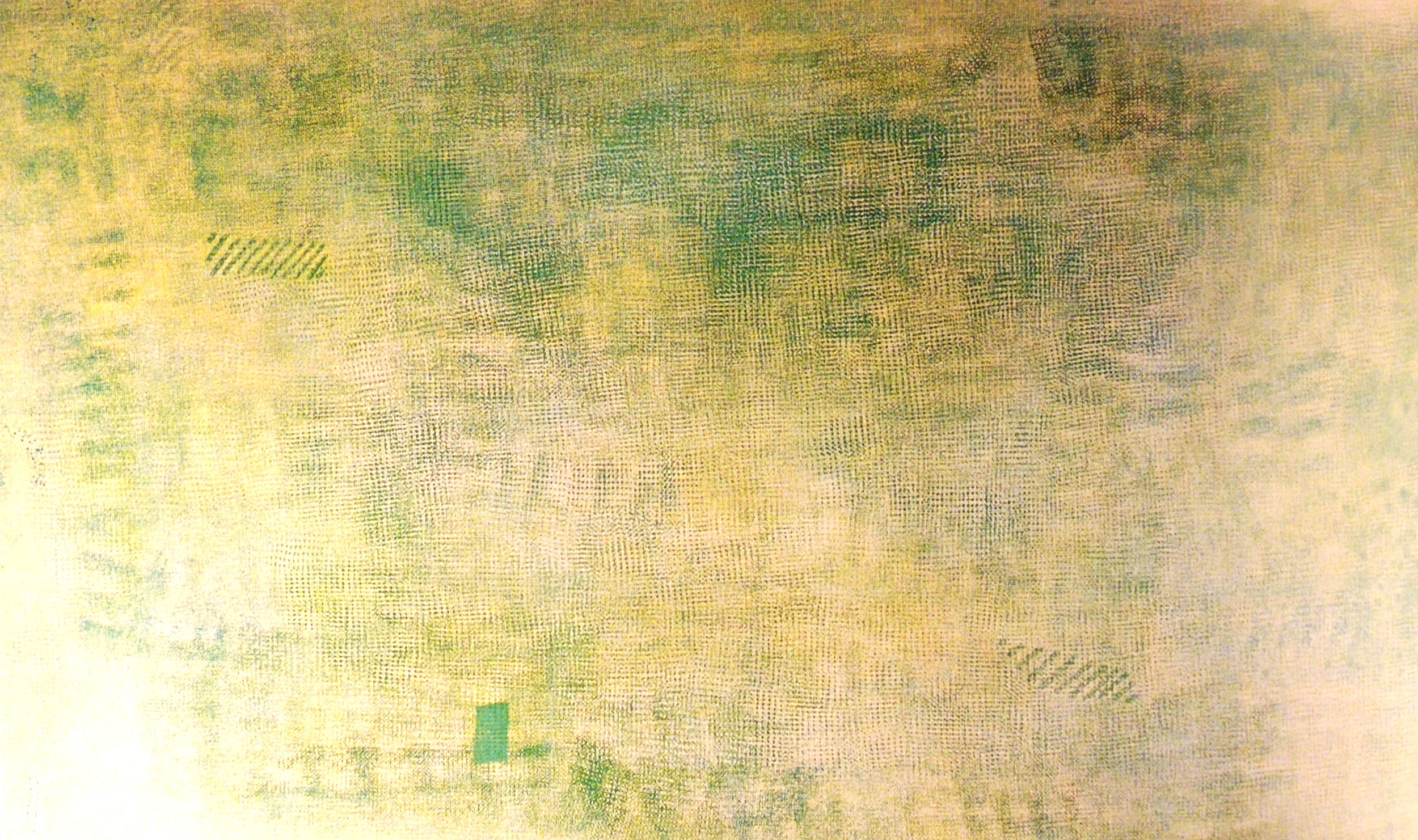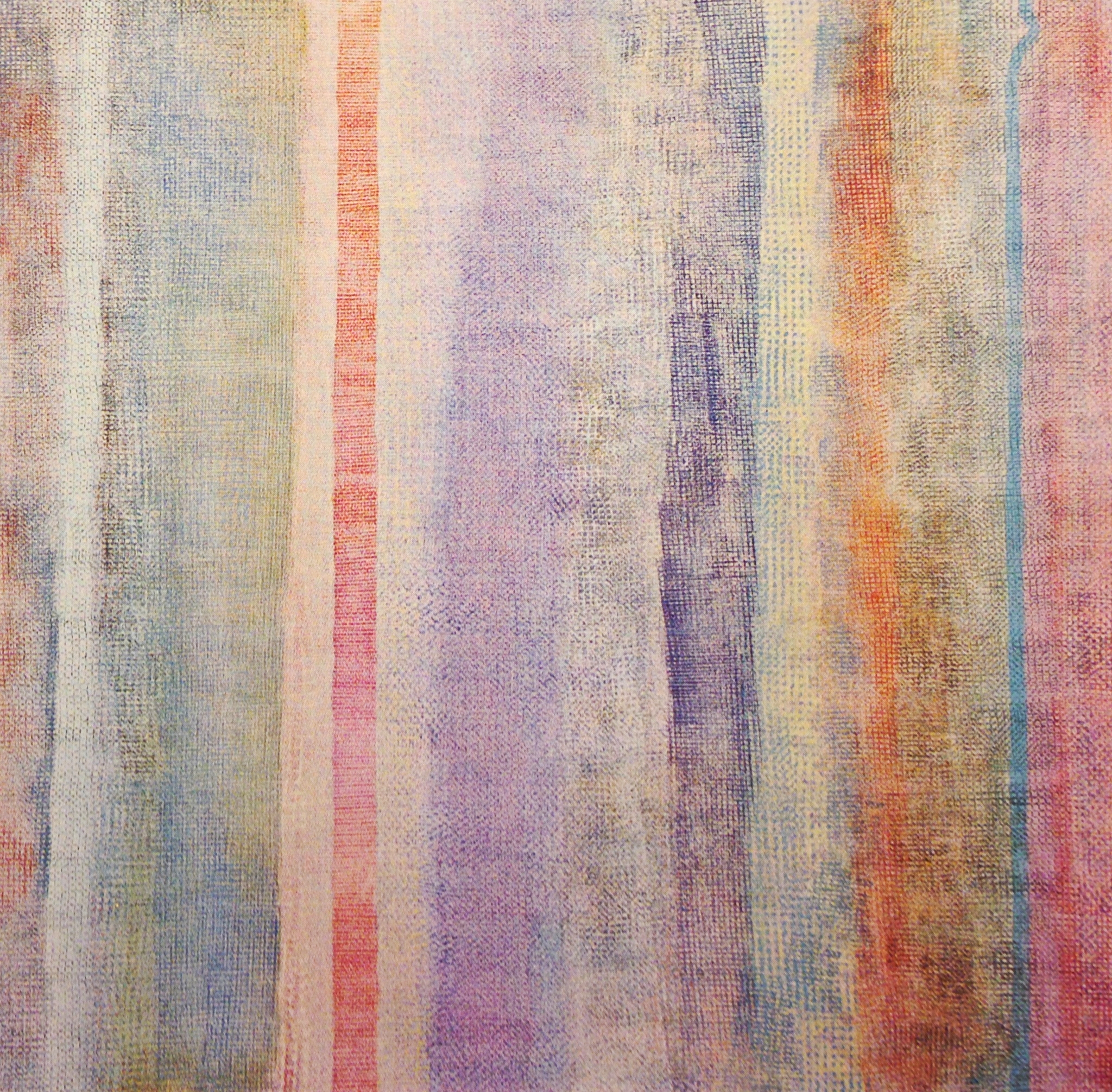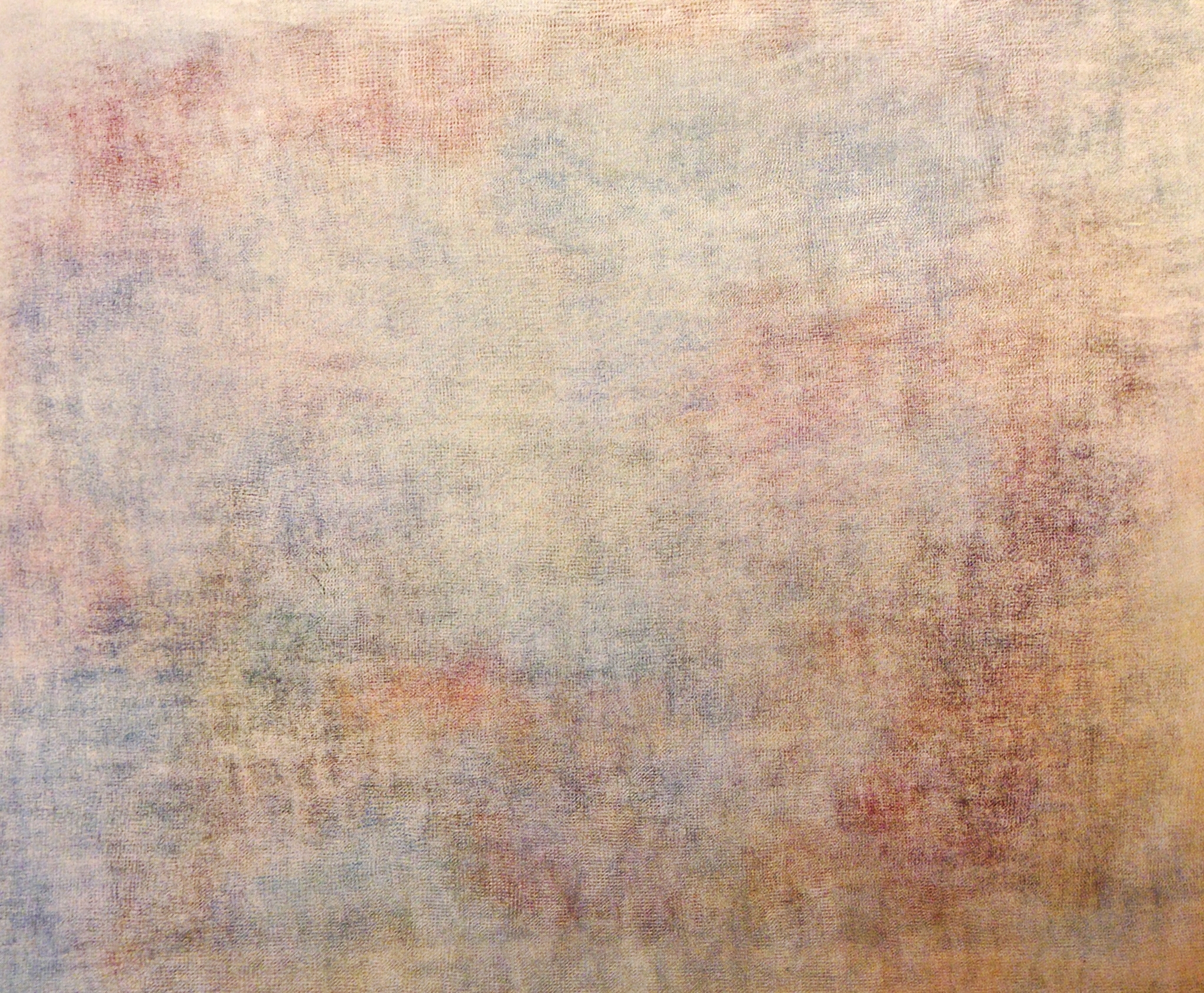This last week I've been writing scenes between Peter and the artist Robert Natkin. Peter went to live with Natkin in 1976 with his first wife Colette and my Sister Sylvie when she was a baby. He was writing a book about him as well as several articles. I am struck by their interactions, their symbiotic relationship as artist and critic and the intimacy they shared over his paintings. The friendship, and my father's belief in Natkin's work lasted his whole life, which was not always the case. There was something about his work that touched him deeply. The visit in 1976 takes up a third of his autobiography "Marches Past":
"I am in the studio. Natkin is talking quickly into the telephone by the racks of paintings. Bright light floods in from the sloping landscape, outside, through the great sliding windows, which take up the whole wall looking out onto a field, and the woods, beyond which lies the barn (where Peter was staying). The pictures here look much richer and stronger than those in the barn earlier this morning. I remember why I enjoy them so much. Huge canvases are stapled flat, against the wall. In front of me is a table on wheels, crammed with paint pots, cloths, sponges and brushes. Assistants come and go, bringing canvases and tools from the stores downstairs." - Peter Fuller, Marches Past, click here to read the full book
Natkin was the only Abstract Expressionist that Peter liked. He articulates for himself very eloquently in the clip and essay below, but I think it's because where most Abstract Expressionist draw from Existentialism and explorations of an impending death, Natkin's paintings are an affirmation of life. Below is a clip from the documentary Mike Dibb made about their relationship.
Essay by Peter Fuller for the introduction to Robert Natkin's 1976 exhibition at Andre Emmerich Gallery
Over the last 20 years, Robert Natkin has established several "pictorial types" in his painting. He has given each of these a generic name, including Apollos, Field Mouse. Intimate Lighting. Bath, and most recentty, Face paintings. These categories are recurring constellations rather than chronological "periods." Of course, each has specific iconographic and stylistic characteristics, and its own developmental history. But, as Jonathan Fineberg has pointed out, most of these modes have their origins in Natkin's early life, "more in terms of their associations to a type of experience than to format sources." The distinction is important. Even today, each type can best be defined through the kind of perceptual experience which it offers to the viewer rather than by a descriptive account of its "format" elements.
For example, in this exhibition Natkin's work shows some significant transformations. The Bath and Apollo paintings, which once seemed to be his polarities, have been brought together to form a new synthesis. Of course, analysis of what has happened involves scrutiny of the development of Natkin's devices, conventions, and visual vocabulary. But he is not a painter who is concerned with the realization of the imminent qualities of his medium for their own sake. And so this can never be enough. When Natkin arrives at a new organization within his painting he is not exclusively concerned with the transcendence of established formal devices. He is also seeking to express a fresh totalization of certain experiences of being within the world. Although his pictorial conventions are neither "literary," nor "representational," they nevertheless function as signifiers. They refer to the experience of a reality other than that constituted within the painting itself. Analysis of these canvases thus involves consideration of the way in which that experience can be realized by others through receptive perception: the given elements are only invitations, or necessary preconditions, to meaningful events which take place in the act of seeing.
Gate Of Shrine 1976
Gate of Shrine is a characteristic fusion of the Bath and Apolfo types. On looking at this painting, the eye first perceives a surface consisting of loosely organized, interwoven, vertical bands whose colour values have been calculated in such a way that, initially, the illusion of a continuous, translucent "curtain," seemingly illuminated from behind, is created. The vertical emphasis compels the eye to travel up and down, as it does when watching the surface of a sheet of falling water, such as that to be seen in Paley Park. But interest in the visual relations between one band and another also pulls the eye across, horizontally. Inevitably, this analytical, traverse movement is far less fluid than the first, and during the course of it the insufficiency of a visual caressing of the painting's "skin" becomes apparent, as a number of contradictions begin to assert themselves. The "bands" on the right (detached from the top and bottom edges of the canvas) seem to extract themselves from the interwoven surface, and to appear as transparent columns, floating in front of an illusory space. The "gate" reveals itself as that area (to the left of centre) in which the "curtain" becomes as impossibly insubstantial as a breath of mist. The eye is then drawn in towards the illusion of an opening haze of recessive light and space, apparently situated behind that which was originally perceived as the continuous surface. The latter now dissolves into hanging shreds, a green gash, and receding veils. At this moment, the viewer finds himself touched by the terror of nothingness, by the threat of an engulfment within the illusion of an unbound space, which is not even relieved (as many of the earlier pure Bath paintings were) by the presence of drifting iconographic devices.
Thus the seeing of a painting like Gate of Shrine does not amount to a simple relationship between the viewer, as subject, and the marks on the canvas, as given objects. Perception resembles involvement in a drama: the observer feels himself to have been drawn through a curtain into events which unfurl and unravel as he looks. Since that which happens is realized within his consciousness, he cannot detach himself from these events, or locate them wholly "out there," as something separate from himself.
An understanding of the way in which Natkin arrived at the Bath Apoflos can make it easier to grasp the kinds of experience which Jhey are potentially offering. He began producing Apollo paintings in 1960: initially, he divided the canvas into clearly defined, vertical ribbons of variable width and "value." These tended to be more autonomous, impenetrable, and regularly shaped than the bands in Gate of Shrine. Natkin did not start to lay his paint down in successive, transparent veils of colour until he invented a technique of using indented cloths wrapped around sponges (instead of brushes) in the early seventies. Thus, in the first Apollos, the paint was often opaque: the bands functioned rather like flattened columns, or painted pillars, arranged across the front of an unseen stage. Of course, they did not present an unbroken "wall." The value of some was dominant over that of others. A few seemed to step forward; others presented themselves as doorways, or windows; yet more suggested ambiguous "slabs" of sky. Nevertheless, the overall effect which they created was that of a carnival parade in front of a space which was constantly suggested, but rarely revealed. As the parallel with a suspended cloth is often useful in considering Natkin's painting, it may be helpful to think of the vertical bands in the early Apollos as constituting a decorated "safety curtain": the viewer engaged with them, enjoyed the sensuality, and brilliance of their colours, and the boldness of their juxtapositions. But, in the end he accepted the fact that they excluded him by holding him off at the threshold. They remained uncompromising in their erect verticality. Their brilliant blues and fiery reds could never dissolve into an elusive veil, through which the eye might pass into a full illusion of an engulfing space behind.
Although the Intimate Lighting paintings (of which the Bath canvases are a particular variety) self-evidently relate closely to the Apollos, represent quite a different moment in Natkin's work. On looking at them, it is as if the hints, promises and clues of an infinite space, implied behind the colorful Apollo parade, have been brought forward, and fully exposed, so that they become the content of the paintings. There is, of course, an alluring "skin" of light which initially appears to be a seductively unified surface. But this illusion is much less resistant to the probings of the eye than the shut doors of the Apollos. The superficial sheen soon dissolves into its components so that the observer feels himself to be sucked inwards. There is no vertical, compositional barrier to bar the way, and prevent engagement with this illusory and seemingly boundless depth. These paintings extract quite a different kind of relationship from that demanded by the Apollos. They do not argue. They literally entertain and embrace. They are inclusive.
Perception of these Intimate Lighting paintings thus involves engagement with inclusive spatial paradoxes, alluring skins of light, and particular experiences of limitless depth (and also of time). Elsewhere, recognising the sense of fear to which this constellation gives rise, I have tentatively related it to Natkin's creative resurrection and exploration of certain "lost" aspects of the infant's relations with the mother, and her breast. Within this relationship, the conceptions of space, of inside, outside, other and self as delimited by skin are distinct from those arrived at through adult perception of external objects. Part of the power of the Intimate Lighting paintings may derive from their revival of the paradoxes and fears which prevailed in the intimacy of this infantile consciousness of the mother.
Similarly, it is not difficult to discover in the Apollos certain generalized references to experiences deriving from the infantile relationship with the father. Natkin, himself, has provided specific verbal associations. He has spoken of the origins of the Apollo imagery in visits to a cinema (of that name) with his father; in a carving of the Greek sun god in his chariot, which was situated above the proscenium arch there; and in the fusion of these experiences with Oedipal dreams of hammering at shut doors behind which the primal scene of parental intercourse was taking place. Disallowed from entering the forbidden space, in the dream Natkin felt himself to be becoming of ever diminishing size.
Of course, knowledge of these particular associations is no more than a contingency when it comes to an appreciation of the paintings themselves. Nevertheless, even after Natkin's intimate, biographical material has been subject to such radical transformation through the act of making these paintings, something of the original experience often remains (even it it cannot consciously be identified) as residual content which informs the whole. Thus, I do not think that it is absurd to say of the Apollos that they reflect, in some way, the child's ambivalent perception of the resplendent yet terrifying power of the father. The vertical columns which argue with the viewer might be said to be holding him back from reentering the intimate, lost space of fusion with the mother — in one sense, the 'subject" of the parallel Bath and Intimate Lighting series. Certainly, the space of the infant-mother relationship may commonly be described as an inclusive suffusion; whereas that between the father and the child tends to be strident, and exclusive.
Sartre once wrote, "A life develops in spirals. It passes again and again by the same points but at different levels of integration and complexity." There is a sense in which the evolution of Natkin's various modes of painting can be seen as a record of the movement of these spirals. But the transformation of the levels involved into an abstract, "aesthetic" vocabulary is his way of transcending the specific, and metamorphosing it into something which is visually enticing and satisfying. In the new Bath Apollos, two separate biographical "points"—two distinct varieties of relational space—are brought together in a new conjuncture. Certainly the different levels of "integration and complexity" which this involves can be referred to in "formal" terms: but these cannot be equated with the realization of the full value of the new images in perception.
The Bath Apollos are not the only recent development of Natkin's "pictorial types." The Faces, too. have emerged out of the Bath and Intimate Lighting series. Of course, this title should not be taken as a literal reference to representational figuration. However, in these paintings Natkin's earlier, even distribution of a "scatter balance" has been modified: frequently, there is a sharpening of the focus around a central recessive vortex, over which certain iconographic markings float. This accentuation of the centre tends to emphasize the process of inclusive engulfment. Here, the initial sheen is like St. Veronica's veil. The shimmering "face' on the cloth, often surrounded by the gentle pinks of flesh, attracts the eye; but as we burst through it, we find ourselves lost in the illusion of swirling loneliness, and boundless depth. The attraction, and the terror of these paintings again seems, in part, to arise from their displaced insistence on a common experience, which each of us has individually forgotten. For the infant, the face of the mother acts like a mirror image: she responds to his movements with hers. Nevertheless, her face is also the means through which he learns of his separateness from her, his otherness. In the moments of disjuncture between his movements, and her responses, he slowly learns of the absoluteness of the isolation of the self. He simultaneously defends against the terror of helplessness, and of nothingness, to which this gives rise. Natkin, too, seduces us with the gentle, domestic intimacy of the surface "skin" of these paintings, only to threaten us with an illusory void as we keep looking. W. R. Bion, the psychoanalyst, once described the ability of some of his patients to glimpse within themselves, for brief moments, "a domain of the nonexistent.' At such times, Bion wrote, '"Space" becomes terrifying or terror itself: "Le silence de ces espaces infinies m'effraie." ' It is towards such momentary glimpses of a spacial terror that Natkin entices his receptive viewers in this series of paintings. —Peter Fuller 1976











